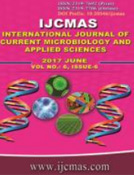


 National Academy of Agricultural Sciences (NAAS)
National Academy of Agricultural Sciences (NAAS)

|
PRINT ISSN : 2319-7692
Online ISSN : 2319-7706 Issues : 12 per year Publisher : Excellent Publishers Email : editorijcmas@gmail.com / submit@ijcmas.com Editor-in-chief: Dr.M.Prakash Index Copernicus ICV 2018: 95.39 NAAS RATING 2020: 5.38 |
The purpose of this study was to develop an efficient protocol for genotype independent gene transformation in cotton (Gossypium hirusutum) a worldwide commercially important fibre crop, to reduce the adverse impact of harmful chemicals used to control biotic stress. Most cotton varieties remain recalcitrant and amenable to genetic manipulation to protocols so far developed. The commercially significant Indian cotton cultivars NH-615 and NH-635 were successfully transformed using shoot apex as explants. Shoot apices were aseptically isolated from 6 day old seedlings and co cultivated with Agrobacterium tumifaciens strain EHA 105 harbouring the recombinant vector pCAMBIA containing Cry1Ac gene under control of CaMV 35S promoter; neomycin phosphotransferase (nptII) gene as selectable marker. Inoculated explants were placed for two days on co cultivation medium. Transformed shoots were selected on MS (Murashige and Skoog 1962.) basal medium supplemented with 75mg/l kanamycin and 200mg/l cefotaxime. Multiple shoots subsequently regenerated on MS + 0.5mg/l BAP resulted in high kanamycin resistant multiple shoot induction (16.5 and 13 plants of NH-615 and NH-635 respectively by applying RBD statistical analysis). A total 40 explants were cultured under each treatment in 4 replications. At the same time a tissue culture independent Agrobacterium mediated in planta transformation protocol was followed to overcome recalcitrance in cotton regeneration. Germinating seedlings of NH-615 with just emerging plumules were inoculated with a separate strain of Agrobacterium LBA4404 carrying gene construct PBI121 that carries GUS (β- glucoronidase) and selectable marker gene nptII to confirm the transformability of the cultivar. Maximum of the germinated plants were positive for GUS showing either tissue specific expression or blue spots in at least one plant part. Callus derived from cotyledonary nodes of NH-615 also showed transformation efficiency by blue colour formation in GUS histochemical analysis. This research is the foremost and successful transformation protocol for the genetic improvement of university developed cotton cultivar NH-615 and NH-635 and this protocol will be useful to research students as well as cotton breeders to develop biotic stress resistant cotton which is one of the important perspectives of AICRP under Cotton Research Station Nanded, VNMKV Parbhani.
 |
 |
 |
 |
 |